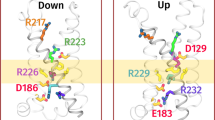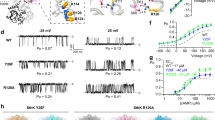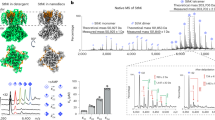Abstract
The Ciona intestinalis voltage-sensing phosphatase (Ci-VSP) couples a voltage-sensing domain (VSD) to a lipid phosphatase that is similar to the tumor suppressor PTEN. How the VSD controls enzyme function has been unclear. Here, we present high-resolution crystal structures of the Ci-VSP enzymatic domain that reveal conformational changes in a crucial loop, termed the 'gating loop', that controls access to the active site by a mechanism in which residue Glu411 directly competes with substrate. Structure-based mutations that restrict gating loop conformation impair catalytic function and demonstrate that Glu411 also contributes to substrate selectivity. Structure-guided mutations further define an interaction between the gating loop and linker that connects the phosphatase to the VSD for voltage control of enzyme activity. Together, the data suggest that functional coupling between the gating loop and the linker forms the heart of the regulatory mechanism that controls voltage-dependent enzyme activation.
This is a preview of subscription content, access via your institution
Access options
Subscribe to this journal
Receive 12 print issues and online access
$189.00 per year
only $15.75 per issue
Buy this article
- Purchase on Springer Link
- Instant access to full article PDF
Prices may be subject to local taxes which are calculated during checkout







Similar content being viewed by others
References
Murata, Y., Iwasaki, H., Sasaki, M., Inaba, K. & Okamura, Y. Phosphoinositide phosphatase activity coupled to an intrinsic voltage sensor. Nature 435, 1239–1243 (2005).
Okamura, Y., Murata, Y. & Iwasaki, H. Voltage-sensing phosphatase: actions and potentials. J. Physiol. (Lond.) 587, 513–520 (2009).
Worby, C.A. & Dixon, J.E. Phosphoinositide phosphatases: emerging roles as voltage sensors? Mol. Interv. 5, 274–277 (2005).
Okamura, Y. & Dixon, J.E. Voltage-sensing phosphatase: its molecular relationship with PTEN. Physiology (Bethesda) 26, 6–13 (2011).
Kohout, S.C., Ulbrich, M.H., Bell, S.C. & Isacoff, E.Y. Subunit organization and functional transitions in Ci-VSP. Nat. Struct. Mol. Biol. 15, 106–108 (2008).
Villalba-Galea, C.A., Miceli, F., Taglialatela, M. & Bezanilla, F. Coupling between the voltage-sensing and phosphatase domains of Ci-VSP. J. Gen. Physiol. 134, 5–14 (2009).
Kohout, S.C. et al. Electrochemical coupling in the voltage-dependent phosphatase Ci-VSP. Nat. Chem. Biol. 6, 369–375 (2010).
Jia, Z., Barford, D., Flint, A.J. & Tonks, N.K. Structural basis for phosphotyrosine peptide recognition by protein tyrosine phosphatase 1B. Science 268, 1754–1758 (1995).
Barford, D., Flint, A.J. & Tonks, N.K. Crystal structure of human protein tyrosine phosphatase 1B. Science 263, 1397–1404 (1994).
Andersen, J.N. et al. Structural and evolutionary relationships among protein tyrosine phosphatase domains. Mol. Cell. Biol. 21, 7117–7136 (2001).
Tabernero, L., Aricescu, A.R., Jones, E.Y. & Szedlacsek, S.E. Protein tyrosine phosphatases: structure-function relationships. FEBS J. 275, 867–882 (2008).
Lemmon, M.A. Membrane recognition by phospholipid-binding domains. Nat. Rev. Mol. Cell Biol. 9, 99–111 (2008).
Matsuda, M. et al. Crystal structure of the cytoplasmic phosphatase and tensin homolog (PTEN)-like region of Ciona intestinalis voltage-sensing phosphatase provides insight into substrate specificity and redox regulation of the phosphoinositide phosphatase activity. J. Biol. Chem. 286, 23368–23377 (2011).
Denu, J.M., Stuckey, J.A., Saper, M.A. & Dixon, J.E. Form and function in protein dephosphorylation. Cell 87, 361–364 (1996).
Lee, J.O. et al. Crystal structure of the PTEN tumor suppressor: implications for its phosphoinositide phosphatase activity and membrane association. Cell 99, 323–334 (1999).
Sarmiento, M. et al. Structural basis of plasticity in protein tyrosine phosphatase 1B substrate recognition. Biochemistry 39, 8171–8179 (2000).
Iwasaki, H. et al. A voltage-sensing phosphatase, Ci-VSP, which shares sequence identity with PTEN, dephosphorylates phosphatidylinositol 4,5-bisphosphate. Proc. Natl. Acad. Sci. USA 105, 7970–7975 (2008).
Murata, Y. & Okamura, Y. Depolarization activates the phosphoinositide phosphatase Ci-VSP, as detected in Xenopus oocytes coexpressing sensors of PIP2. J. Physiol. (Lond.) 583, 875–889 (2007).
Halaszovich, C.R., Schreiber, D.N. & Oliver, D. Ci-VSP is a depolarization-activated phosphatidylinositol-4,5-bisphosphate and phosphatidylinositol-3,4,5-trisphosphate 5′-phosphatase. J. Biol. Chem. 284, 2106–2113 (2009).
Maehama, T. & Dixon, J.E. PTEN: a tumour suppressor that functions as a phospholipid phosphatase. Trends Cell Biol. 9, 125–128 (1999).
Maehama, T., Taylor, G.S. & Dixon, J.E. PTEN and myotubularin: novel phosphoinositide phosphatases. Annu. Rev. Biochem. 70, 247–279 (2001).
Bezanilla, F. How membrane proteins sense voltage. Nat. Rev. Mol. Cell Biol. 9, 323–332 (2008).
Isom, D.G., Cannon, B.R., Castaneda, C.A., Robinson, A. & Garcia-Moreno, B. High tolerance for ionizable residues in the hydrophobic interior of proteins. Proc. Natl. Acad. Sci. USA 105, 17784–17788 (2008).
Yerushalmi, H. & Schuldiner, S. An essential glutamyl residue in EmrE, a multidrug antiporter from Escherichia coli. J. Biol. Chem. 275, 5264–5269 (2000).
Liu, L., Baase, W.A., Michael, M.M. & Matthews, B.W. Use of stabilizing mutations to engineer a charged group within a ligand-binding hydrophobic cavity in T4 lysozyme. Biochemistry 48, 8842–8851 (2009).
Zheleznova, E.E., Markham, P.N., Neyfakh, A.A. & Brennan, R.G. Structural basis of multidrug recognition by BmrR, a transcription activator of a multidrug transporter. Cell 96, 353–362 (1999).
Muth, T.R. & Schuldiner, S. A membrane-embedded glutamate is required for ligand binding to the multidrug transporter EmrE. EMBO J. 19, 234–240 (2000).
Shoichet, B.K., Baase, W.A., Kuroki, R. & Matthews, B.W. A relationship between protein stability and protein function. Proc. Natl. Acad. Sci. USA 92, 452–456 (1995).
Iijima, M., Huang, Y.E., Luo, H.R., Vazquez, F. & Devreotes, P.N. Novel mechanism of PTEN regulation by its phosphatidylinositol 4,5-bisphosphate binding motif is critical for chemotaxis. J. Biol. Chem. 279, 16606–16613 (2004).
Rahdar, M. et al. A phosphorylation-dependent intramolecular interaction regulates the membrane association and activity of the tumor suppressor PTEN. Proc. Natl. Acad. Sci. USA 106, 480–485 (2009).
Walker, S.M., Leslie, N.R., Perera, N.M., Batty, I.H. & Downes, C.P. The tumour-suppressor function of PTEN requires an N-terminal lipid-binding motif. Biochem. J. 379, 301–307 (2004).
Edelhoch, H. Spectroscopic determination of tryptophan and tyrosine in proteins. Biochemistry 6, 1948–1954 (1967).
Otwinowski, Z. & Minor, W. Processing of X-ray diffraction data collected in oscillation mode. Methods Enzymol. 276, 307–326 (1997).
Collaborative Computational Project, Number 4. The CCP4 suite: programs for protein crystallography. Acta Crystallogr. D Biol. Crystallogr. 50, 760–763 (1994).
Emsley, P. & Cowtan, K. Coot: model-building tools for molecular graphics. Acta Crystallogr. D Biol. Crystallogr. 60, 2126–2132 (2004).
Ratzan, W.J., Evsikov, A.V., Okamura, Y. & Jaffe, L.A. Voltage sensitive phosphoinositide phosphatases of Xenopus: their tissue distribution and voltage dependence. J. Cell. Physiol. 226, 2740–2746 (2011).
Acknowledgements
This work was supported by grants to D.L.M. from the US National Institutes of Health (NIH), R01 DC007664, and the American Heart Association (AHA), 0740019N, and to E.Y.I. from the NIH, R01 NS035549 and U24 NS057631. Ci-VSP in the pSD64TF vector was provided by Y. Okamura (Osaka University). GFP-PLC-PH, GFP-TAPP-PH and GFP-GRP-PH were provided by T. Meyer (Stanford University), T. Balla (NIH) and J. Falke (University of Colorado), respectively. Kir2.1 was provided by E. Reuveny (Weizmann Institute of Science). We thank members of the Minor and Isacoff labs for support throughout these studies. D.L.M. is an AHA Established Investigator.
Author information
Authors and Affiliations
Contributions
L.L., S.C.K., S.M., E.Y.I. and D.L.M. conceived the study. L.L., S.C.K., Q.X., S.M. and C.R.K. conducted the experiments and analyzed data. E.Y.I. and D.L.M. analyzed data and provided guidance and support throughout. L.L., S.C.K., E.Y.I. and D.L.M. wrote the paper.
Corresponding author
Ethics declarations
Competing interests
The authors declare no competing financial interests.
Supplementary information
Supplementary Text and Figures
Supplementary Figures 1–6 and Supplementary Tables 1–4 (PDF 3378 kb)
Supplementary Movie 1
Morph of 241 Form I copy B (open) and 241 Form II copy B (closed) structures. Members of the hydrophobic α456 pocket are highlighted in yellow. Other colors are as in Figure 1. (MP4 28767 kb)
Rights and permissions
About this article
Cite this article
Liu, L., Kohout, S., Xu, Q. et al. A glutamate switch controls voltage-sensitive phosphatase function. Nat Struct Mol Biol 19, 633–641 (2012). https://doi.org/10.1038/nsmb.2289
Received:
Accepted:
Published:
Issue Date:
DOI: https://doi.org/10.1038/nsmb.2289
This article is cited by
-
The structural basis of PTEN regulation by multi-site phosphorylation
Nature Structural & Molecular Biology (2021)
-
A126 in the active site and TI167/168 in the TI loop are essential determinants of the substrate specificity of PTEN
Cellular and Molecular Life Sciences (2018)
-
Allosteric substrate switching in a voltage-sensing lipid phosphatase
Nature Chemical Biology (2016)
-
A lipid two-step
Nature Chemical Biology (2016)
-
A novel mechanism for fine-tuning open-state stability in a voltage-gated potassium channel
Nature Communications (2013)



